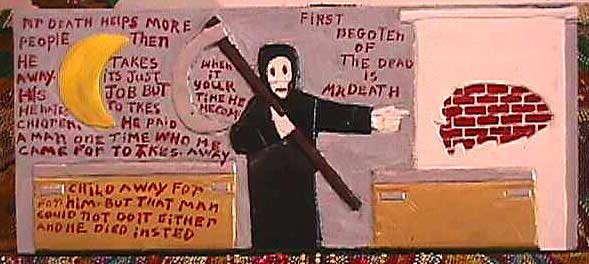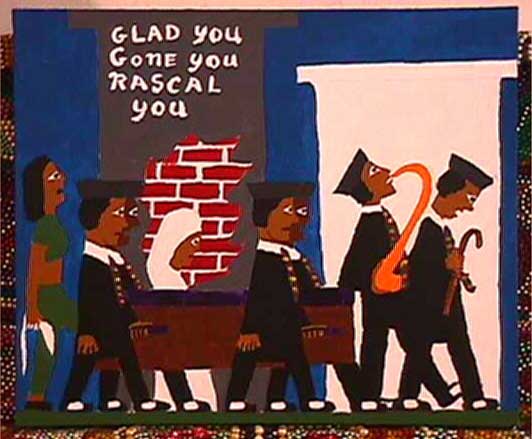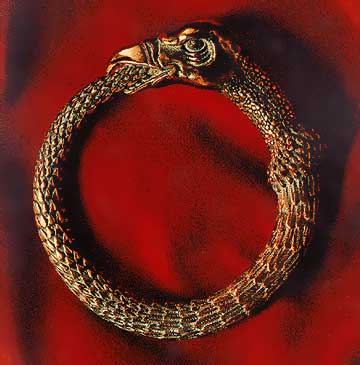Algiers is a
part of New Orleans that most visitors never see.
Its small Baptist churches, dangerous looking bars,
dilapidated houses and vacant industrial lots are
home to some of Americaās worst urban poverty and
crime, but good people also live honest lives there,
in a culture steeped in spirituality and religion.
Algiers is also home to Herbert
Singleton, one of Americaās acclaimed vernacular
artists, whose walking sticks, sculptures and
bas-relief panels form part of most major
collections of contemporary Southern folk art in
the US (and also appear in the Collection de lāArt
Brut in Lausanne, Switzerland). Sitting on his
front steps sipping a beer, Singleton eyes the
street running past his narrow front yard, and
muses on the 60-inch television set inside his
barely furnished home: he bought it after hitting
the lottery. Talent and will go further than luck
in Algiers, and in his front room, pieces of
driftwood and scavenged wood planks awaiting
revelations from his chisels and mallet are the
raw materials of Singletonās most reliable angle
on survival.
Singletonās
workspace is a patch of grass in his backyard and
the bare wood floor of his living room. With a set
of well-worn tools, he carves tree stumps and
limbs, cedar cabinet panels and cypress doors,
then paints their complexly layered wood surfaces
with a bold but limited palette of glossy enamel
house and car paint. He marks the walking sticks
and sculptures with geometric motifs, vivid color
contrasts, emphatic figures and depictions of
reptiles, and applies similar aesthetics to the
masterfully stylized bas-relief panels. All reveal
striking parallels with the traditional carvings
of West Africa, but their themes of racism,
violence and religion, and the handwritten script
recalling roadside signage and religious messages
from another era, are distinctly of the American
South.

Catch Me
If You Can
Herbert has been, from time to
time, preoccupied with this
Zarathustra-like hero who dances on the
abyss and spits into the mouth of the
volcano -- this panel is a splendid
realization of that theme. Cedar (41x21)
The subjects of Singletonās wood
panels also include depictions of street life in
Algiers: the black struggle, New Orleans jazz
funerals and biblical stories. Many read like
autobiography, written in raw, personal imagery,
both literal and metaphorical. Their simple,
cartoon-like figurations convey irony and humor as
well as stark emotions. One piece, showing a
shackled black man pursued by dogs declares: ĪMy
affliction have brought me to shame. I am among a
nation of people that have no mercy on the hearts
and souls of black people. I can only say this is
a good night to die.ā A sign on a casket in one of
his jazz funeral scenes reads ĪGlad You Dead You
Rascal You,ā a line borrowed from a 1929 song by
New Orleans jazzman Sam Theard and made famous by
Louis Armstrong.
Singleton has spent nearly 14 of
his 58 years in prison, most of them in the
Louisiana state penitentiary at Angola, a former
plantation once worked by African slaves. Two .38
bullet wounds testify to his violent past. His
furrowed face can change from a stoic mask to a
charming smile in a flash as he deflects questions
about talent or inspiration. ĪPeople make out that
my art is some kind of great thing, but for me it
aināt no big deal ö it pays the bills,ā he says.
Singleton started carving at age
17, first making voodoo-inspired walking sticks
from river driftwood. With a long tradition in
African-American culture, such sticks are perhaps
the most direct link in American folk art to
African influences. Gallery owner, art historian
and Singleton patron, Andy P. Antippas wrote in Souls
Grown Deep (1), that in both African and
African-American cultures walking sticks
historically played spiritual, functional and
decorative roles, and were used in witchcraft,
divination and healing ceremonies brought to the
New World by African slaves.
ĪIn Africa,ā wrote Antippas, ĪAs
migratory tribes became more settled, the walking
sticks once used as implements for herding or
warding off predators ·often became more formally
decorative staffs, usually bearing emblems of
hierarchal rank or social position among
African-American carvers, you begin to see
similarities with European canes·and the influence
of the Old Testament, with its many references to
staffs. Singleton makes both walking sticks ö
sometimes used in New Orleans for protection
against two legged urban snakes, and larger staffs
which convey power and authority with seemingly
priestly intent ö either in voodoo or referencing
Old Testament prophets. In his pieces, snakes
going up a staff represent the effort to re-enter
heaven and the snakes going down represent the
Fall into Perdition.ā

This
is a very personal piece for Herbert
with
a complex history (which will follow, upon
request).
Cedar, (41x23)
As with most African-American
vernacular artists, no readily apparent reason
exists for the strong African impulses in
Singletonās work. Speculation that there is an
inexplicable connection to African blood-roots has
fascinated many critics, but Herbert Singleton has
never revealed interest in African or other
ethnographic arts. Some of his carved doors are
remarkably similar to Yoruba panel doors in
present-day Nigeria, and his carved tree stumps
resemble Yoruba divination pieces to the deity Shango.
But the tall totemic poles also recall indigenous
cultures from the American Northwest. Antippas
concludes that these Īinterestingā parallels are
Īprobably the fortuitous results of the materials
he works with.ā
Voodoo is the indisputable link to
Africa. It was brought to New Orleans in the 19th
century by slaves from Haiti, and is still
intricately wound into the local culture.
Singletonās early totems, carved with grotesque
faces, included the words ĪVoodoo Protectionā. In
many African cultures, such pieces are used to
scare off wandering spirits. The hundreds of
spirits in the voodoo pantheon invest their power
in both African imagery and in corresponding
identities, including Catholic saints. Voodoo
symbols including skulls, crucifixes, coffins and
African animals, all inhabit Singletonās artwork,
alongside intrinsically personal representations
of decadent street life in Algiers, guns and drug
paraphernalia.
Many of Singletonās first walking
sticks were sold to pay drug debts to a local pimp
known as ĪBig Hat Willieā, who occasionally used
them as weapons. That relationship also led to the
first sentence in Angola, which deprived him of
nearly a decade of carving. On returning, the
artist went to work for a self-styled voodoo
doctor named Charles Gandolfo, assisting with
swamp tours, and taking visitors into the woods
for staged rituals. From the driftwood he picked
up, he returned to carving and Gandolfo sold
walking sticks for him, often adorned with
carvings of snakes and crocodiles, which became
known as Īkiller sticksā after a French Quarter
buggy driver supposedly used one to beat off a
mugger.

John
Coltrane: ''Monkey on
His Back.''
On the
far right, Singleton has intuited
the presence of Miles Davis. Part of
the Baltimore Visionary Museum's
exhibition.
Cedar,
(60x20)
Around 1988, Singleton started
experimenting with bas-relief panels. While the
raw materials of his walking sticks and sculptures
limited the compositions to natural wood forms,
doors and cabinet panels offered a broad, blank
canvas for his imagination. He initially drew on
voodoo imagery for inspiration, then experimented
with more personal subjects. Still recovering from
a near-fatal shooting and in the process of
kicking a drug habit, Singleton suffered from a
stomach ailment which he was convinced was caused
by snakes ö under a voodoo hex. Two
autobiographical pieces from that time interpreted
the illness through voodoo imagery and, he
believes, produced a cure. The first shows a
skeleton with red and yellow snakeheads poking
through its ribs: serpents representing his
unhealed wounds, his addiction, and the malignant
spirits which held him. A second piece shows a
black man pulling two large white snakes from
bodily orifices. ĪAfter I done it, that pain went
away,ā says Singleton. At the same time, he was
creating totems for a local spiritualist church
whose members ö like the voodoo practitioner ö
used them in healing rituals.
An outpouring of panels followed.
Their subjects ranged from the Old Testament to
the exploits of ĪMop Topā, a prison cohort who
terrorized fellow inmates with broken mop sticks.
Perhaps his most powerful pieces deal with the
struggles of Americaās black underclass. Singleton
strikes the difficult balance between
recapitulating stereotypes and ridiculing them in
broad burlesque. Drawing on history, New Orleans
street culture, and his own life, he interprets
not only the racial oppression of a dominant white
culture but also the self-destructive conflicts
within his own black community.
|

Strange Fruit:
Singleton's
response to the ''Without
Sanctuary'' exhibition reflecting
upon the
Southern ''tradition'' of
photographing lynchings. The
design of the
tree must be considered brilliant.
Carved, in this case, from a pine
panel. (59x19)

New Orleans
Slave Auction: ''Africa Done
Sold You
New
Orleans Inspects You.''
Cedar, (41x20)
|

Mr.
Death:
An
unusually text filled piece
which
will be explained at length.
Cedar (44x20)

Killer
Stick
Singleton
has not made a ''killer
stick'' for a decade. This is
a vintage staff from c.1990.
It features a demon's head at
the top, a trident at the
bottom, and a snake creeping
up the shaft.
Oak, (59'')
|
|

Glad
You Gone You Rascal You:
A
rare painting by Herbert.
Oil Enamel on Canvas
(20x24)
|
Among his
most visually complex and detailed pieces,
Singletonās biblical panels often draw on personal
experience whilst seeking broader truths.
Humanityās sinful nature, a search for salvation,
and the retributions of a personal God are
recurrent themes. A recent example, ĪHell is
Deep and Hot,ā shows archangel Michael
defeating Satan as two African angels fall into
the dark abyss. Accompanying text reads:
ĪWhosoever causeth a man to go astray in an evil
way shall fall himself into his own pit·You can
see the prophecies of Revelations out on that
street ö brother killing brother, daughter against
the parents and parents against the daughters. The
Bible says all of that was coming to pass.ā
Although he
knows the Bible from cover to cover, Singleton is
no churchgoer. ĪThe Bible is right there for
anyone who wants it ö thatās my church, all the
church I need. What voodoo comes down to, what it
all is, is faith by proxy...donāt matter if itās a
voodoo queen or preacher or psychiatrist. Itās
faith by proxy.ā Turning to a cedar panel,
Singleton returns to his carving, not knowing
where the piece will take him but sure that
paradoxes and revelations are waiting in the wood.
1. Souls
Grown Deep: African American Vernacular Art of
the South. Volume One, eds. William Arnett,
Paul Arnett. Tinwood Books, Atlanta, Georgia,
2000.
http://www.rawvision.com/back/singleton/singleton.html

Dr.
Kilikey, the Heroin Man:
A
dreadful fellow upon whom West Bank
junkies called when they couldn't
find a vein. Part of the Baltimore
Visionary
Museum's exhibition.
Cedar, (41x21)



